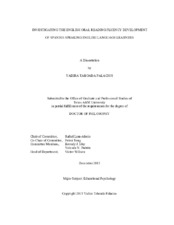| dc.description.abstract | This is a quantitative study derived from a five-year longitudinal federal experimental research project targeting Spanish- speaking English language learners (ELLs) receiving language services across four different program models: control/experimental structured English immersion (SEI) and control/experimental transitional bilingual education (TBE). The purpose of this study was to: (a) investigate the L2 oral reading fluency trajectories from grade 1 to grade 3 for a sample of Spanish-speaking ELL students participating for the fourth year in the enhanced/experimental TBE (TBE-E) and the enhanced/experimental SEI (SEI-E) program models; (b) investigate to what extent English (L2) initial oral reading fluency status impacts L2 reading fluency growth rate and (c) compare instructional models, SEI-E and TBE-E, in their ability to promote L2 oral reading fluency development. Participants consisted of 244 students with at least one time point of the six oral reading fluency measures used over the span of the three years.
Structural equation modeling was utilized. A Piecewise growth model was specified and estimated. The time-invariant covariate of group membership was added to investigate whether there were statistically significant differences in L2 oral reading fluency development for ELLs in SEI-E and TBE-E. All three estimates were found to be not statistically significant. That is, variations on the average initial score and the growth trajectories at both stages of development were not attributed to students being in different program models. In regards to the impact the intercept had on the growth rates, the results show that there was no statistically significant relationship between the intercept and growth during the first timepiece, but there was a statistically significant relationship between intercept and growth on the second stage of development. The -0.506 estimate indicates a moderately strong statistically significant negative relationship between initial score and growth. Students with the lower scores on intercept, middle of grade 1, experienced the greater growth from end of grade 2 to the end of grade 3.
The findings in this study support the existent literature that indicates non-linear trend of L2 ORF trajectories for ELLs. In this study, ELLs in SEI-E and TBE-E followed a two-stage linear oral reading fluency trajectory. Students on average were reading 21.270 word read correctly per minute, wcpm, at the initial status. The trajectory consisted of statistically significant positive linear growth for the first stage of development, with an average increase of 23.993 wcpm. Although there was a deceleration in growth rate from the first to the second stage in the trajectory, it still consisted of a statistically significant positive growth rate. ELLs in both groups were still making gains, but their growth rate decelerated past the middle of grade 2. On average students grew at a rate of 10.338 wcpm during this part of the trajectory.
This study provides empirical evidence that when controlling for research-based intervention, native language instruction does not hinder the acquisition of English literacy development as it applies to the area of oral reading fluency development. Students in TBE-E were able to achieve the same levels of oral reading fluency in English while maintaining levels of proficiency in their native language. | en |


